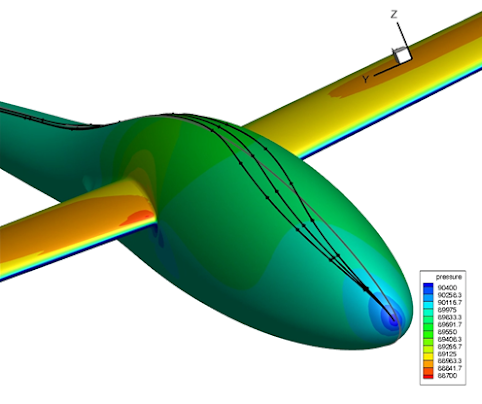Yaw string is a basic "equipement" of our gliders, that often questions the people out of gliding movement. My answer to such inquiry is to say "this is a low cost sideslip sensor" - with a tongue in cheek...
Well yes yawstring relates to sideslip, but at the end do we really know how much the angle we observe every flight relates to sideslip ?
 |
| Yaw string under control... |
First let's define sideslip : it is as a convention the angle between the speed vector projected into wing plane & fuselage axis - a complicated way to describe that it quantify how much sideways the glider is flying. Sideslip is most of the time called "beta" - here is a sketch.
 |
| Sideslip definition |
Now that sideslip is defined, how much yawstring angle relates to sideslip ?
To answer this question, Computationnal Fluid Dynamic results (CFD) provides a good view on fuselage local aerodynamic behavior.
Below is the flow picture obtained from CFD for a typical glider at beta=+4deg of sideslip (wind blowing on the right cheek of the pilot...).
 |
| Friction line for a typical glider with 4deg of sideslip & 4deg of aoa |
Glider skin is colored according to local pressure, and friction lines
are plotted, which are showing the flow direction right onto the skin.
Those lines are illustrating how much locally the airflow is being
"deformed" by fuselage presence, and in particular the way it is flowing
laterally in symetry plane when sideslip is present.
We can consider that the friction line at one location on the glider is giving the orientation of yaw
string placed there - given a whool string is very thin compared to
glider size & very close to fuselage skin. With appropriate post processing, the angle of
friction lines versus glider symetry plane can be
numerically evaluated from CFD output, and used for further analysis
CFD results in several condition have been considered, to characterize yaw string response to glider parameters. Here is the plot of for yaw string angle computed for a typical canopy location, with Aoa ranging between 0 & 8 deg, and Sideslip between 0 & 8deg as well
 |
| Yaw string angle in relation to sideslip |
The following observation can be made
- Yaw string angle mostly respond to glider sideslip, and there is more yaw string angle than actual sisdeslip: yaw string is an amplifier for glider sideslip
- In term of magnitude, typical "yaw string gain" is 2.5, that is when sideslip is 1deg, yaw string angle reads 2.5deg.
- To a lesser extend, response of yaw string to sideslip evolves slightly with aoa - that is "yaw string gain" evolves slightly between cruise & circling phases
Another type of investigation can be made from CFD : when fixing the glider conditions, the gain of yaw string can be computed for various position over the glider. The following curve can be plotted, that gives the yawstring gain versus its relative positionning versus nose, in proportion to maximum height.
(e.g : Nose distance/max fuse height=0.85 on a 80cm high fuselage means yawstring is placed 0.85*90=76.5cm away from the nose)
 |
| Yaw string gain in relation to yaw string positionning vs fuselage nose |
From this curve, it can be observed that the more forward on fuselage is (Nose distance/max fuse height toward 0), the greater the yaw string gain is, that is the more the yaw string amplifies the sideslip. This may help you tune the position of your yaw string, depending how much you want it to be active.
A small statistical study for yaw string positioning over 8 modern single seaters of various class, and 3 double seaters has been performed, with following findings :
- On single seater or in forward seat of double seater, yaw string generaly lies between 0.85 & 1.05 times the max fuselage height from nose, meaning yaw string gain is in the range of 2.4 to 2.6
- For the instructor seat of double seater, yawstring lies much further back, close to 2 times the max height from the nose : in that region yaw string gain is expected to be much closer to 1. That is instructor reads less sideslip from yaw string than his pupil does !
For sure there are exception to this rule when glider fuselage shape is out of the ordynary - typically yawstring gain on a Libelle would likely show a somewhat different behavior.
May be you will now look differently to your yaw string when you are flying !